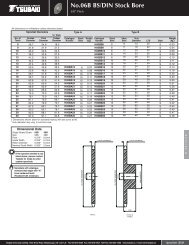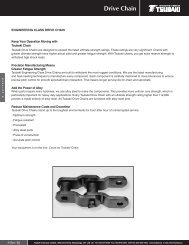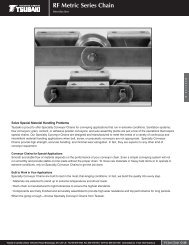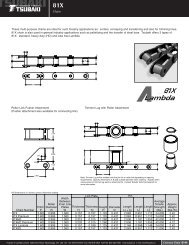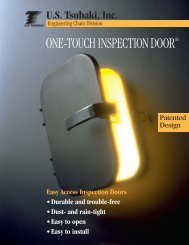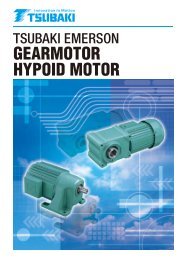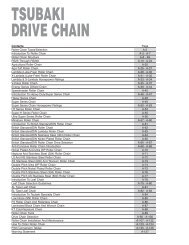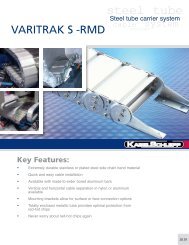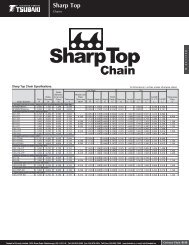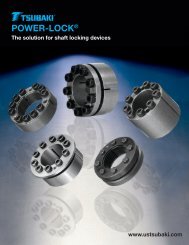DRIVE CHAINS - Tsubaki
DRIVE CHAINS - Tsubaki
DRIVE CHAINS - Tsubaki
Create successful ePaper yourself
Turn your PDF publications into a flip-book with our unique Google optimized e-Paper software.
Before Use For Safe UseStandard Roller Chains Lube-Free Roller Chains Heavy Duty Roller Chains Corrosion Resistant Roller Chains Specialty Roller Chains Accessories Selection Handling9.3 Pin RelatedSymptom Possible Causes RemedyBreakage of pin.Static fractureThe type of fracture foundwhen subjecting the chain tothe breakage test. Occurs whenchain is subjected to a loadgreater than its breakage strength.Pin rotates or begins tostick out.NormalWear or rust occurs onlyat the connecting pin ina lifting application orsimilar operation.Excessively large shock loads.Subject to a repetitive load greaterthan the fatigue limit of the pin.Corrosion.Fatigue fractureOccurs when the pin is repetitivelysubjected to loads greater than itsfatigue limit. Re-check the size ofthe peak load and formulate acountermeasure.9.4 Bush / Roller RelatedSymptom Possible Causes RemedyRoller and/or bushingsplits. (Falls off)Roller does not rotate.Excessive load or improper lubrication.Operating a chain at high load withoutproper lubrication can create frictionbetween the pin and bush, causingthe pin to rotate. In this condition, thepin may come out, leading to chainbreakage.Improper initial lubrication at installation.Excessive load or speed of rotation.Inadequate lubrication.RS11-SS-1, RS15-1, RS25-1, RS35-1Reduce shock loads by making the start-up, stopping, andother actions smoother.Remove the large repetitive load. Otherwise, increase thesize or number of chains.Install a casing to protect the chain. Periodically clean andlubricate the chains.Shock-induced bending fractureThe pin is subjected to a large shock load andbreaks. The side with the initiating point receivestensile load, and the fracture progresses fromthis point. A pin is especially susceptible tobecoming weak with regard to bending whenthe surface of the pin has corroded. This type ofphenomenon occurs quite easily.Replace with new chain. Improve the lubrication or loadingconditions.Replace with new chain immediately. Do not weld orreuse the pins. (Dispose of the old chain to be sure that itis not used again by mistake.) Also, if the pin head or linkplate surface is worn, check the installation.Replace the connecting link. If pin wear is excessive,replace the chain also. Take special care to properlyinstall the connecting section for devices such as endbrackets used for lifting applications, etc.Choose a different chain according to the kW ratings table.Replace the chain. Provide adequate lubrication accordingto the operating conditions.Fatigue fracture.Reached the point of fatigue during operation and eventually broke. Impact withthe sprocket teeth at a force exceeding the chain's transmission capacity.The inner link plate is moving inward, orthe bush is cracked.A bushed chain and not a roller chain is being used.Replace with a new chain. Re-inspect the installation andload conditions.Foreign particles have gotten betweenthe bush and roller.Periodically clean the chain. Install a casing to protect thechain.Roller is opening up.Excessive load.Reduce the load. Provide adequate lubrication.173Roller is becominghourglass shaped.Excessive load or inadequatelubrication.Replace with new chain. Improve the lubrication or loadingconditions.



